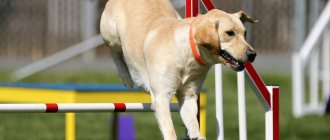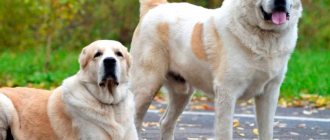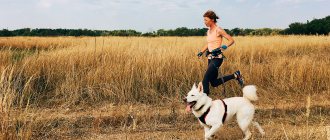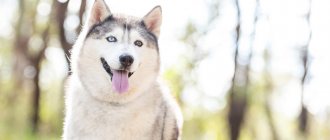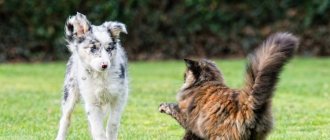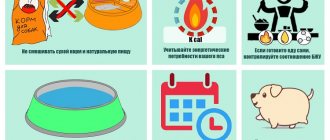Are you dreaming of a Labrador? We'll tell you if this breed is right for you and how to care for these beautiful dogs so that your friendship will last for many years.
A Labrador puppy is an ideal choice for families with children.
He is a guide and a rescuer,
Both a hunter and a sapper.
Children's best friend is a buddy.
Meet the Labrador!
(Found on the Internet)
A dog is man's friend. This expression perfectly characterizes the Labrador. If you choose a representative of this breed as a pet, you will never regret it. This wonderful dog will become the best friend for all family members: he will adore and touchingly protect your children, give warmth and joy to grandparents, and for his owner will be the best incentive not to sit on the couch at home, but to go for a long walk.
In turn, the future owner must be prepared for the fact that the Labrador is a large and active dog that requires attention, sufficient walking and quality food. Like any living creature, a dog can get sick, and this will require additional costs for trips to the veterinarian and treatment.
Anyone who wants to have a pet, no matter what breed, must realize that a four-legged friend is a huge responsibility for someone else’s life, health and well-being. But the joy from daily communication will be no less. Few people are capable of such sincere and devoted love as a dog, who will look forward to your return from work and rejoice, no matter whether you are happy or sad, poor or rich, healthy or sick. The only thing she expects from her owner is love.
Labrador is the very embodiment of canine love. It seems that his tail never stops wagging for a minute, and his muzzle “smiles” at the sight of a person. If you have firmly decided that you are ready to take responsibility and can make this cheerful companion happy, then it will not be a bad idea to first familiarize yourself with the characteristics of the chosen breed.
Marina Radostnaya , the owner of the first Labrador puppy selection service “Labrdom,” told FAN editors everything about the character, exterior and maintenance of these dogs
History of the breed and its purpose
To better understand the breed, you need to know how and where it came from.
Many people think that the name “Labrador” comes from the island of the same name in Canada, by the way, the second largest in the world after Arabia. According to one version, this is true, but there are two others. According to the first, the dogs, which initially had an exclusively black color, got their name from the igneous rock “labradorite”. If you believe the second, then Labradors began to be called that way thanks to the light hand of the Portuguese, who, noticing their incredible performance, began to call the animals Labradors, which translates as “hard worker.”
The history of the breed dates back to the 19th century. It is interesting that the distant ancestors of these dogs did not live in Labrador at all, but on the island of Newfoundland, which became the homeland for four-legged furry giants with the same name. In addition to these good-natured bumpkins, there lived more compact dogs that were faithful companions of local fishermen. The Englishman Peter Hawker was impressed by the outstanding working qualities of these animals and took several individuals back to their homeland in the UK. In Foggy Albion, during breeding work, these natives of North America were crossed with Curly (curly-haired retrievers). According to some reports, the blood of the English foxhound and setter, a type of English pointing dog, may also flow in the veins of modern Labradors.
The British, known for their passionate love of hunting, noticed these tireless, agile and at the same time very receptive to training dogs, and they began to be actively imported to England. In 1870, the animals received their well-known name, and in 1887 a unified breed standard was established.
Two aristocratic families at once wanted to engage in professional breeding - the Earls of Malesbury and the Dukes of Buccleuch. The first nursery was in Hampshire, and the second in Scotland. Tireless workers quickly fell in love with noble families, who began to widely use them as companions for hunting birds and small game. Dogs were valued for their endurance, flexibility, intelligence, loyalty and ability to bring prey without spoiling it. The wide distribution of Labradors was also facilitated by their outstanding exterior.
In 1903, a significant event happened for the breed - it was recognized by the prestigious and very first kennel club in the world, The Kennel Club, and in 1916, the Labrador Retriever Club organization was founded, which exists to this day.
Initially, the English Kennel Club recognized only one color - the original black. For quite a long time, other varieties were not allowed for breeding, but later fawn and chocolate colors were also recognized, which dog breeders immediately fell in love with.
Representatives of the breed came to the Soviet Union in the 70s of the last century, but did not immediately become widespread.
People who are not very well versed in dog breeding often confuse Labradors with the Golden Retriever, believing that they are representatives of the same breed, differing only in color and coat length. Marina Radostnaya explains that these are two different breeds. The main difference is that goldens (also called golden retrievers) have long hair and are allowed only one color of varying degrees of saturation - from almost white to golden-red, while smooth-haired Labradors are black, fawn, and chocolate.
“In terms of temperament, golden retrievers are calmer and less active,” says the breeder.
pixabay.com/
Purpose
Today, the Labrador is one of the most popular breeds both in our country and abroad, which successfully combines beauty, intelligence and excellent working qualities. Its main purpose, but far from its only purpose, is as a companion dog, however, thanks to its outstanding intelligence and high learning ability, they are useful in a variety of areas. Representatives of this breed successfully work in the police and help their two-legged partners search for explosives and drugs, serve as guides for the visually impaired and blind, and search for people under rubble.
Separately, it is worth highlighting the area where Labradors are especially good due to their good-natured disposition - this is canis therapy. This is an unconventional treatment technique that brings excellent results. Dogs are used to treat autism, cerebral palsy, Alzheimer's disease, mental retardation and other serious illnesses. A complete cure, unfortunately, is impossible, but both the attending physicians and the patients’ relatives note significant improvements in their condition. It has been noticed that thanks to communication with dogs that have undergone special training, the level of anxiety in patients decreases, phobias, neuroses, aggression and hyperactivity go away, motor skills develop, intellectual development and memory improve, and coordination of movements improves.
Dogs of this “profession” undergo a very serious selection process, the main criteria of which are a high level of trainability and a complete absence of aggression towards people and their own kind. From both points of view, Labradors fit perfectly and cope with their responsibilities perfectly.
pixabay.com/
Characteristics and description of Labrador: breed standard
Let's figure out what a real Labrador should look like with the help of our expert.
When assessing a dog’s exterior, professionals are guided by the general standard adopted in the new edition at the very beginning of 2011.
According to its provisions, the Labrador Retriever is a fairly large dog, distinguished by a strong build and compact body.
The head should be well balanced in relation to the body. The skull is wide, with a well-defined transition from the forehead to the massive muzzle. Jaws - with a regular scissor bite, strong but soft, not too long. The eyes are medium size, different shades of brown. The ears are hanging and wide.
The neck is powerful and strong, well defined. The body is short and strong, the chest is wide. The tail has a so-called “otter” shape, very thick at the base and tapering towards the tip. Does not bend over onto its back, even when the dog is in an excited state.
The coat is short and dense with a dense undercoat. Waviness is considered a defect.
The colors are uniform without spots (a small splash of white on the chest is allowed), various shades of the main color are possible.
As for size, there is an opinion that there are two types of representatives of the breed - English and American. According to this theory, the “English” have a more massive physique and are more like their distant ancestors, while the “Americans” are less stocky and shorter. The reason for the differences lies in the fact that US breeders relied on working qualities and sought to breed lighter and more athletic dogs, so the pets of their lines turned out to be leaner. In Great Britain, in turn, they took care of preserving the constitution characteristic of the ancestors of modern Labradors, which are more preferable for exhibitions and shows. However, it should be noted that this division is very arbitrary, and be that as it may, there is a single standard that professional breeders adhere to when conducting breeding work.
Here is what Maria Radostnaya says about the size of representatives of this breed: “When you want to get a Labrador, it is important to remember that this is a large dog that needs a lot of space. Of course, it all depends on the dog’s build; each Labrador has its own constitution. On average, the growth rate is 56-57 cm at the withers for males and 54-56 cm for females. Weight can vary on average from 28 to 36 kg.”
pixabay.com/
Diseases
Every breed of dog has a predisposition to certain diseases. Labrador retrievers are no exception to the rule. To prevent health problems, it is necessary to carry out timely examination, vaccination and deworming.
Here are the most common diseases in Labradors:
- Obesity.
- Dysplasia of the hip or elbow joints.
- Panosteitis.
- Osteochondrosis.
- Licking granuloma.
- Retinal atrophy.
- Cataract.
- Epilepsy.
The likelihood of the occurrence and development of diseases in representatives of the Labrador Retriever breed can be reduced using gene mapping, but the risk still remains.
Labrador personality
Representatives of this breed are famous for their docile and friendly disposition, which has helped them win the love of dog lovers around the world. It is difficult to imagine a more humane creature than a retriever. When he sees his owner, this dog literally breaks into a “smile” and strives to please him in everything, as long as he is scratched behind the ear and praised from the bottom of his heart. These dogs become especially attached to children and become their best friends. You can leave them to play together without any fear and be sure that your four-legged friend will never harm your baby. By taking a Labrador puppy into your home, after a while you will have the most devoted nanny in the world.
Aggression is completely alien to them, they get along well with other pets, be it a cat or another dog. This implies their quality as an absolute lack of security qualities. Whether this is a plus or a minus is up to the future owner to decide, but this fact cannot be ignored. If you are sure that if you keep a big dog, then it must certainly guard the house, then these good-natured dogs are not for you.
“The Labrador is not a shepherd, and there is a long-held belief that Labradors do not have the aggression gene. They are not suitable for guard work. It is important to know that the Labrador will be afraid of something along with you, because he is, first of all, a companion dog and a devoted friend, ready to support you in any life situations,” explains Marina Radostnaya.
“These dogs are very kind even to those who harm them. They are also amazing actors, sensitive to the emotions of the people around them. We often hear stories from Labrador owners about how their pets lift their spirits or support them in difficult times,” says the breeder.
photo from the personal archive of Marina Radostnaya /
How to choose the right puppy
Before you start looking for a puppy, you need to decide on the purpose of purchasing a dog. If the owner is not inclined towards a show career, he can buy a pet-class baby. These puppies do not fully meet breed standards, but have a good pedigree. Breeding and show class puppies are aimed at show careers and breeding.
You should not buy babies from your hands or from an advertisement. There is no guarantee that in a few months the dog will not grow into an unknown mixed breed. In addition, there is a high risk of hereditary pathologies. The ideal option is to visit several exhibitions, take a closer look at the dogs, collect complete information about the breed and stand in line for a puppy from the parents you like. You can limit yourself to visiting a few official nurseries.
During the conversation with the breeder, you need to ask all your questions and review the documents: puppy card, vaccination card and documents of the parents.
When meeting puppies, pay attention to:
- condition of fur, skin, teeth;
- presence/absence of discharge from the nose and eyes;
- the shape of the abdomen (it should not be bloated);
- presence/absence of rash and irritation;
- gait;
- relationships with relatives;
- reaction to strangers.
You should not take timid or hyperactive puppies: both conditions are deviations from the norm.
Where to buy and price
The Labrador Retriever is a popular breed in Russia, so finding an officially registered kennel is not difficult.
The most famous include:
- Key to Marvel (Tula);
- From the Royal Court (Pokrovskoye village, Moscow region);
- Neardamo Kennel (Orenburg);
- Amber Kingdom (Bataisk, Orenburg region);
- Ten Strike (Magnitogorsk);
- Hunter For Dream (Balashikha);
- Windup Burberry (Moscow).
Average cost of puppies: 22,000-45,000 rubles.
Nicknames for a male Labrador: Ajax, Alpheus, Barney, Vincent, Gray, Thunder, Hector, Casper, Lord, Mason, Oscar, Onyx, Prince, Spirit, Tone, Tyson, Caesar, Charlie. Nicknames for girls: Alice, Athena, Belle, Hermione, Goldie, Blackberry, Yesenia, Comet, Cassandra, Lily, Melissa, Nika, Sabrina, Sophie, Freya, Chimera, Sherry, Emily.
Comparison of breeds and mestizos
Choosing a breed is a very important decision. Therefore, in order not to make a mistake, it is recommended to consider several options. The following breeds are often compared:
- Newfoundland and Labrador. The Newfoundland is a large (up to 74 cm) long-haired dog with a black color. It is not suitable for apartment living, and its coat requires careful care. Labradors are much more active than Newfies. The latter become passive and lazy with age. In addition, the life expectancy of a Newfoundland is only 10 years. Both breeds make excellent companions and can work as rescue dogs.
- Husky and Labrador. Huskies are not suitable for apartment living. They need increased loads and running with weights. They love space and will suffer in cramped conditions. Huskies become attached to only one person and are quite jealous. Labradors simply love people. Huskies are working dogs, Labradors are nannies and companions.
- Labrador or Shepherd. Both breeds require professional training. Shepherds are used mainly for protection; Labradors do not have a guard instinct. Shepherd dogs obey one person and have a tendency to aggression.
- Labrador or Rottweiler. Labradors are more active and friendly. Both breeds require professional training. Rottweilers are moderately sociable and friendly. They get along worse with cats and relatives, but are tolerant of teenagers. The Rottweiler is suitable as a watchman and bodyguard. The Labrador is a guide, hunter, rescuer, but most of all, a companion.
The popularity of Labrador retrievers provokes interbreed matings. The most common types of mestizos:
- Mixed breed of husky and labrador. It is distinguished by erect, pointed ears, like those of a husky, and light color. Perfect for hunting. Retains the behavioral characteristics of the husky - stubbornness, independence and touchiness.
- Mixed Husky and Labrador. The most spectacular cross. She combines the body of a Labrador with the blue eyes of a husky. The color is usually spotted. This cross is similar in character to a husky, has watchdog instincts, and is suspicious of strangers. Loves outdoor games and knows how to communicate with children.
- A cross between a Shar Pei and a Labrador. One of the rarest mestizos. Looks like a Labrador with erect ears and a few folds. Has protective qualities and is prone to stubbornness. Compatible with other dogs. Gets along well with children.
Mestizos, like purebred individuals, need professional training. Mixing temperaments can give unexpected results. Therefore, it is better to raise a puppy under the supervision of a specialist.
Labrador content. Walk
Anyone who is planning to take a puppy of this breed into their home must take into account that this is a fairly active dog for people with the same position in life. Representatives of this breed are suitable both for living in the city and for keeping in a private house with a plot.
“For this breed, the most important thing is that there is a person nearby, so it doesn’t matter at all where this all happens: outside the city or in the city. The only thing that those who are going to buy a Labrador need to take into account is that he needs a long walk to maintain good physical shape, you need to be prepared for this,” warns Marina.
However, sometimes half an hour can be enough for a full walk if you spend it usefully playing with the dog, thereby forcing it to splash out the accumulated energy and spend the calories it has eaten, which is very important, because Labradors can be prone to obesity and their weight needs to be maintained under control. Regarding games, everything is very individual. Some people like frisbees and pullers (this is a special rubber ring), some balls, some ropes. Many dogs literally go crazy from the dot left by a laser pointer (here you need to be extremely careful not to get the beam in the eyes). All this will fade into the background in any case, because between toys and a person he will always choose the latter.
Adult dogs usually go for walks twice: in the morning and in the evening; if desired, you can also take them out at lunchtime to brighten up your pet’s leisure time and not keep him confined to four walls all day. Ideally, if time permits, it is better to extend the walk for an hour or two.
Long exercise will bring pleasure to these “energizers” in absolutely any weather. They do not need special clothing - their thick undercoat will prevent them from freezing. Unless it makes sense to buy a raincoat that will protect the wool from dirt and save you from unnecessary washing. During the cold season, some owners try to put special boots on their paws to protect their paws from reagents, but rarely do any shoes last long on an active Labrador.
If you live in a country house, then the first thing you need to understand once and for all is that this dog is strictly not a street dog! A Labrador will not be able to live outside in a kennel. And even a warm enclosure is not his story. This breed is only suitable for living in a house, next to a person, but not outside.
photo from the personal archive of Marina Radostnaya /
Receptivity to training
As mentioned above, Labradors are very easy to train and have a high level of intelligence. Some difficulties may arise solely through the fault of the owner, who does not always take into account some of the impulsiveness of his pet. We give the floor to the experienced and train his brain so that there is no time to be distracted by extraneous stimuli. Under no circumstances should you shout or even hit the dog. Rough physical force is the worst thing you can think of. This is a bad way to earn your dog's respect and the fastest way to lose his trust. This way the Labrador will only develop fear, and not an understanding of what you want from him.
If you manage to interest the dog and show him who is boss in the good sense of the word, then he will definitely not be bothered by outrages like picking him up from the ground, wallowing in all sorts of nasty things, and having a tight leash.
In general, the Labrador has three weaknesses: children, food and water. If a Labrador sees a puddle on the street, it will dive in head over heels. In such cases, we recommend being proactive: if you see a puddle, distract the dog’s attention (for example, with the “twist” command) and choose a different way around,” explains Marina Radostnaya.
Photo
You have become acquainted with the Labrador breed, the photo of which is presented above. A responsive, trusting, friendly, kind dog with an incredibly “cozy” appearance is the dream of any owner. Labrador is very family-oriented and loyal. This explains why young couples prefer to have this breed.
Interesting facts about the breed
The Labrador is the only dog with webbed feet. This structural feature makes them unsurpassed swimmers in the canine world.
Dogs love to hold objects in their mouths. They have a soft jaw, but the owner must ensure that the pet has more toys. Otherwise, he will switch his attention to other objects in the house.
Labradors have a very high pain threshold. It is not surprising that they are selfless and can rush into the very center of a fire or disaster in order to save people.
They have a sense of smell that is 25% higher than that of the German Shepherd.
The breed, along with the English bulldog, Pekingese, boxer, and German shepherd, is among the TOP 7 most popular breeds.
Grooming
Labradors are quite unpretentious and do not require special care. Their fur does not tangle and does not require frequent brushing. Natural lubrication gives it water- and dirt-repellent properties. It is impossible to say that the dog will not get dirty at all, but there will be no difficulties in washing it. In most cases, it is enough to wipe your pet with a damp towel. Frequently washing an animal with shampoo is not recommended at all, so as not to disturb the natural protective layer, unless it is soiled with something strongly “fragrant”.
Healthy dogs shed profusely 2 times a year, when the coat changes before the new climatic season: autumn and spring. There are ways to speed up this process, for example using a special comb - a furminator, but it is impossible to get rid of it completely. If a Labrador sheds all year round, then most likely this indicates disturbances in the animal’s nutrition.
Nails need to be trimmed as needed, but more often they wear down on hard surfaces during a walk, except for the dewclaws. The dog's ears and eyes should be clean and free of foreign odors. The presence of discharge may indicate errors in nutrition or the presence, for example, of a fungal infection, which is the task of a veterinarian to determine.
photo from the personal archive of Marina Radostnaya /
Cohabitation
To make your family’s life closer to an idyll, learn a number of rules regarding the dog and the child.
- Do not leave two young creatures together unattended, do not let them go for walks together.
- Do not allow your child to pick up the puppy and carry it - this will have a bad effect on the health of both.
- Don't let your baby feed the dog on his own. The dog will get used to taking any food from the hands of the young owner, and the child is able to feed the dog inedible things.
- When the puppy is eating, do not allow the child to distract the puppy. While defending food, the pet is capable of snapping and causing harm to the baby.
- Supervise games between your four-legged pet and your child. If the game is too active, after playing too much, the dog can accidentally bite the child or tear clothes.
The rules seem boring and complicated. If they are carefully followed, the child and four-legged friend will grow up in safety and develop mutual understanding.
Feeding
Our expert claims that the best option for feeding a Labrador is super premium food. It has everything you need for a balanced diet.
During one meal, a dog eats about 200-300g. dry food (it all depends on the manufacturer of the food and the constitution of the individual). An adult animal eats twice a day, morning and evening. It turns out that he needs about 400-600 grams per day. dry food.
Some owners prefer to feed their pet from the table, but this is completely the wrong approach. There is an abundance of excellent balanced food on the market that will provide the dog with everything he needs without additional vitamins and minerals, the amount of which in the diet is extremely difficult to determine on your own.
The health and life expectancy of a Labrador directly depend on the quality of nutrition, as well as on the conditions of detention and genetics. On average, Labradors live 10-12 years. Sometimes these numbers reach 15 and even 18 years.
This is interesting! There is a myth that brown Labradors live longer than their counterparts of other colors. Alas, this is nothing more than long-outdated prejudices from the same series that a “black mouth” is a sign of anger.

